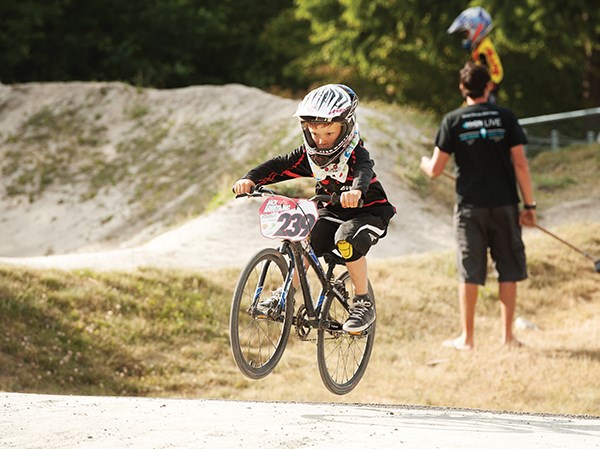For children, running up slides, climbing trees or jumping from heights is more than just a thrill or a tactic designed to scare parents. They’re exploring ‘risky play,’ and it’s incredibly important for their development, explains Dr. Mariana Brussoni, associate professor in the Faculty of Medicine at the University of British Columbia.
“Risky play promotes physical activity, decreases sedentary behaviour and promotes social health and behaviour,” reported Brussoni, a developmental psychologist working in injury prevention.
Yet children are still likely to hear cries of “be careful,” “that’s too high” or “come down,” she said. “But what the child hears is: ‘You don’t trust me, you don’t think I can do this, you think I need you to help manage myself in this world’ and that the world is a very dangerous place.”
But no matter how ‘safe’ you make things, children will always enjoy challenging their limits and adding to the thrill of an experience, said Ian Dailly, vice-president of operations at playground supplier Habitat Systems.
“When you have very active, outdoor children, areas that aren’t intended as play surfaces will become part of the play. They’ll try and climb on roofs, get up posts, walk across arches… a result of them just trying to challenge their limits and add to the thrill of the experience,” he said.
This kind of play also taps into their imagination and creativity, said Allison Green, a child therapist specializing in play therapy. Green added that when kids get bored playing with something in the way it was intended, they’ll find a different way. “The opportunity to explore and try things on their own is really important,” she said. “The more unstructured, the better… as it allows them to test their own limits.”
Brussoni calls this “free play” and explains that it’s great for helping children learn how to design goals and figure out how to reach them.
“Kids with more opportunity for free play show better executive functioning… because if they’re always in supervised activities with an adult telling them what their goal is and how they’re going to accomplish it, they don’t have the opportunity to practise that skill,” she said.
And whether those skills are learned on the playground, the ski hill, a rock face or in the bike park, they all transfer over, said Green.
“A run bike, for instance, builds amazing balance,” which may, in turn, help children excel in areas such as skiing, said Green. And by exploring a variety of activities, children help discover their capabilities.
Dailly agrees, saying that playgrounds such as Stan Clarke Park – which he helped design – help by offering areas for unstructured, risky play using natural elements such as logs and rocks, in addition to traditional playground structures.
However, whether children are hurtling down ski hills, racing bikes or balancing on logs in the playground, the only way they’ll learn to explore the riskier side of play is if parents put a filter on their anxiety-based parenting and only step in if they think something serious might happen – which is far less likely than most think, said Brussoni.
Let them climb the tree, she suggested, but be there to ask: “How do you want me to support you in this?”
“If they can’t make it up the tree themselves, then they can’t make it down the tree, and that’s something they need to figure out for themselves,” she said.
Julie Miller and Ryan Letchford take a similar approach with their two girls, Sola, 5, and Yale, 3, whose activities include racing BMX, ski school, dancing and gymnastics.
“Our rule is: If you can climb there and get there, then go for it. If you can’t, I’m not going to help you because maybe you’re not ready,” said Miller. This way, her girls gain a real confidence boost when they’re successful which, in turn, encourages them to try new things.
The opportunity to explore the riskier side of play and try so many active things in �ϰ������ϲʿ�����¼���� is wonderful for the family’s health, she said, but it brings with it pressure for all children to embrace these activities, which they may feel uncomfortable doing.
The couple received flack, she said, for not putting a daughter into ski school at three years old, even though they knew she wasn’t ready. And though they felt strongly about their decision, they felt guilty for months, she explained.
Green also chose not to place her older boy in ski school because it wasn’t the right fit. “You feel that pressure and sometimes question yourself: Am I doing something wrong? But that’s when you have to really listen to what is best for my child,” she said.
Instead, Green fosters the activities that he does like because this, she said, will help build confidence in other areas.
And confidence in whatever activity your child chooses to do – risky or not – is something you’re best building little by little, suggested Brussoni. “It’s about that child’s confidence and comfort level. If you push them too far and they’re anxious about it, that’s where you can get into trouble.”
Take your cue from your child, she said, and avoid forcing them to engage in activities that make them uncomfortable. That might mean they would rather visit the playground than race around on two wheels, but there is learning potential in either activity. While watching the child swing from monkey bars, note that bumps and bruises can be seen as souvenirs of playtime well spent.
Remember, said Miller, that active children make for busy parents. “We want to give our children every single opportunity available, but I think that we forget that the opportunity to spend time with just the family is huge…. It’s about trying to find a balance.”




